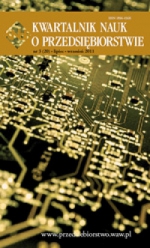Ocena Modelu Kosztu Standardowego
Main Article Content
Abstract
Model Kosztu Standardowego to narzędzie służące do pomiaru obciążeń administracyjnych. Obejmuje wyłącznie koszty administracyjne wynikające z nałożonych przez państwo obowiązków informacyjnych. Cykliczne ich wyliczenia pozwalają uchwycić zmiany dotyczące wymogów biurokratycznych. Wprowadzenie MKS w Polsce jest związane z unijnym programem Lepsze Regulacje, realizowanym dwuetapowo przez Ministerstwo Gospodarki. W artykule zostały omówione mechanizm konstrukcji i wskazane wady. Jednak, jak autorzy podkreślają, pomimo niedoskonałości, MKS może stać się przydatnym narzędziem do ograniczenia biurokracji, co jest celem zasadniczym.
Downloads
Article Details
The author of the article declares that the submitted article does not infringe the copyrights of third parties. The author agrees to subject the article to the review procedure and to make editorial changes. The author transfers, free of charge, to SGH Publishing House the author's economic rights to the work in the fields of exploitation listed in the Article 50 of the Act of 4 February 1994 on Copyright and Related Rights – provided that the work has been accepted for publication and published.
SGH Publishing House holds economic copyrights to all content of the journal. Placing the text of the article in a repository, on the author's home page or on any other page is allowed as long as it does not involve obtaining economic benefits, and the text will be provided with source information (including the title, year, number and internet address of the journal).
References
2. Hercules S., Huijts B., Smend J., The Future of the SCM, Workshop III, Prezentacja wygłoszona podczas spotkania DEBR w Łodzi, 15-17 czerwca 2011.
3. Poprawa otoczenia regulacyjnego w dziedzinie wzrostu gospodarczego i zatrudnienia w Unii Europejskiej, Komunikat Komisji Dla Rady i Parlamentu Europejskiego, COM(2005) 97. http://ec.europa.eu/governance/better_regulation/index_en.htm.
4. Przybylski A., Jak przedsiębiorcy postrzegają bariery administracyjne?, „Administracja Elektroniczna”, 2007/04.
5. Raport z realizacji działań Reformy Regulacji w 2010 roku, Lepsze Regulacje, Ministerstwo Gospodarki, Warszawa 2011, s. 13-14, 15.
6. Review of the Dutch Administration Burden Reduction Programme, World Bank Group, Washington D.C. 2007, s. 7.
7. Szpringer W., Regulacja konkurencji a konkurencja regulacyjna – ujęcie instytucjonalne, Wyd. Poltext, Warszawa 2010.
8. The International Standard Cost Model Manual, International SCM Network to reduce administrative burdens, 2005, s. 6.
9. Trnka D., Perception of regulation by its users, Prezentacja wygłoszona podczas spotkania DEBR w Łodzi, 15-17 czerwca 2011.
10. Weigel W., Standard Cost Model. A Critical Appraisal, 2008, s. 17-19. (http://ssrn.com/abstract=1295861).

